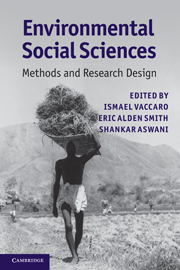Book contents
- Frontmatter
- Contents
- Contributors
- Foreword
- Preface
- 1 Introduction
- 2 People, numbers, and natural resources: demography in environmental research
- 3 Production decisions and time allocation: a guide to data collection
- 4 Analyzing the politics of natural resources: from theories of property rights to institutional analysis and beyond
- 5 Extreme events, tipping points, and vulnerability: methods in the political economy of environment
- 6 Local communities and natural resources: ethnobiology in practice
- 7 Mapping histories: cultural landscapes and walkabout methods
- 8 Metaphors and myths in news reports of an Amazonian “Lost Tribe”: society, environment and literary analysis
- 9 Water decision-makers in a desert city: text analysis and environmental social science
- 10 Linking human and natural systems: social networks, environment, and ecology
- 11 Khat commodity chains in Madagascar: multi-sited ethnography at multiple scales
- 12 Spatiotemporal methodologies in environmental anthropology: geographic information systems, remote sensing, landscape changes, and local knowledge
- 13 Deep time, diachronic change, and the integration of multi-scalar data: archaeological methods for exploring human–environment dynamics
- 14 Comparing trajectories of climate, class, and production: an historical ecology of American yeomen
- 15 Socioecological methods for designing marine conservation programs: a Solomon Islands example
- Index
- References
6 - Local communities and natural resources: ethnobiology in practice
Published online by Cambridge University Press: 05 June 2012
- Frontmatter
- Contents
- Contributors
- Foreword
- Preface
- 1 Introduction
- 2 People, numbers, and natural resources: demography in environmental research
- 3 Production decisions and time allocation: a guide to data collection
- 4 Analyzing the politics of natural resources: from theories of property rights to institutional analysis and beyond
- 5 Extreme events, tipping points, and vulnerability: methods in the political economy of environment
- 6 Local communities and natural resources: ethnobiology in practice
- 7 Mapping histories: cultural landscapes and walkabout methods
- 8 Metaphors and myths in news reports of an Amazonian “Lost Tribe”: society, environment and literary analysis
- 9 Water decision-makers in a desert city: text analysis and environmental social science
- 10 Linking human and natural systems: social networks, environment, and ecology
- 11 Khat commodity chains in Madagascar: multi-sited ethnography at multiple scales
- 12 Spatiotemporal methodologies in environmental anthropology: geographic information systems, remote sensing, landscape changes, and local knowledge
- 13 Deep time, diachronic change, and the integration of multi-scalar data: archaeological methods for exploring human–environment dynamics
- 14 Comparing trajectories of climate, class, and production: an historical ecology of American yeomen
- 15 Socioecological methods for designing marine conservation programs: a Solomon Islands example
- Index
- References
Summary
Introduction
This chapter focuses on methods specific to the field of ethnobiology. Literally, ethnobiology is the study of the logic of life (the logos of bios) among a group of people (ethnos) (Glover 2005: 24). Ethnobiologists examine the knowledge systems that social and cultural communities have developed to explain the natural world. Ethnobiology is also a multidisciplinary field, which means that ethnobiologists use a variety of interdisciplinary methodologies and theories. Ethnobiologists often occupy multiple roles as social and natural scientists. Finally, ethnobiology is at the same time a positivist and interpretative field of inquiry. Scholars conducting ethnobiological research employ a wide range of quantitative and qualitative techniques.
The history of the field has been split into several phases to account for the different schools of thought that have dominated ethnobiology over the years (Ellen 2006; Nazarea 2006; Hunn 2007). The initial phase was a period where researchers were conducting “salvage” ethnobiology in an attempt to document local biological knowledge of economically and medically useful plant species (Ellen 2006: S2; Hunn 2007). Phase two began in the 1950s but peaked in the 1960s and 1970s with the rise of cognitive anthropology. Inspired by linguistic studies of the Prague School (circa 1920s), cognitive anthropologists sought to document and classify folk biological knowledge in order to understand how different cultural groups conceptualize their environment (Nazarea 2006). In this strand, ethnoscientists were primarily concerned with methodologies that could be utilized to elicit local categories while at the same time searching for non-local, cross-cultural grids with which to compare cultural groups. From a theoretical perspective, much of the work generated from this phase focused on demonstrating why it is “notable that nonliterates know so much about nature” (Berlin 1992: 5). Conklin’s agroecological study (1954) of the Hanunóo (Philippines), and Hunn’s (1977) and Berlin, Breedlove, and Raven’s (1974) on Tzeltal Maya classification are all exemplary of this period.
- Type
- Chapter
- Information
- Environmental Social SciencesMethods and Research Design, pp. 110 - 131Publisher: Cambridge University PressPrint publication year: 2010
References
- 1
- Cited by

